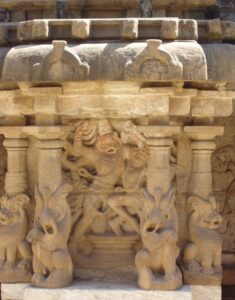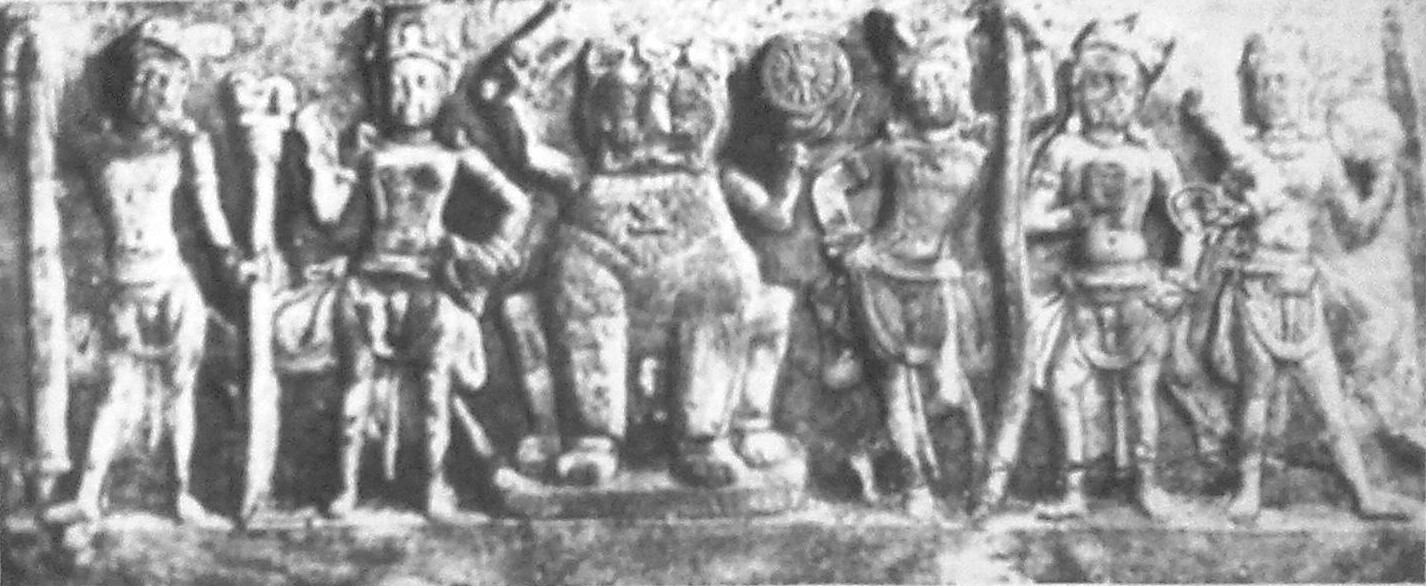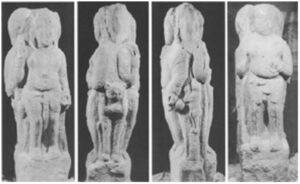Vishnu – the protector among the trinity of Hindu pantheon is popularly worshipped in his ten avatara forms. The earliest indication of the evolution of the avatara theory occurs in the Bhagavad Gita.1 Though there is no definite idea of the avatara in Vedic literature, there is a pre-figuration of several later stories, including the story of the Vamanavatara. Vishnu is here described as a youth of vast body and as striding over the universe, planting his step in three places.2 One phrase of the Rig Veda appears to indicate an epithet, which could be attributed to the form of Vishnu as Narasimha. It clearly calls the qualities of Vishnu that are seen only in this avatara as “like some wild beast, dread, prowling, mountain-roaming”.3
With the tremendous growth of the Vaishnava religion, the avatara concept of Vishnu also developed. J.N. Banerjea says that according to early accounts like Satapatha Brahmana, Taittiriya Samhita and even the Mahabharata, the Matsya, Kurma, and Varaha avatars are considered to be the manifestations of Brahma.4 It is difficult to find when and where these legends were assimilated to the scheme of the avatars of Vishnu.
The kings of north and south India patronized Vaishnavism and had given importance to the Dasavatara concept of Vishnu. The Varaha and Trivikrama avataras gained greater importance during the Gupta period of 4th – 6th c. C.E. This was a period which saw a great revival of Vedic-Brahmanism, the evolution of Puranic religion and the development of the Vaishnava pantheon.5 The retrieval of land or lost kingdom as well as acquisition of a kingdom to rule over is the concept preached in these avataras. So, the king who redeemed or captured a kingdom erected a temple at that place for Vishnu in Varaha form. As far as the Tamil country is concerned, the early Pallava rulers did the same. The Varaha cave and Adivaraha cave temples at Mamallapuram stand as examples of this. The concept of terrifying the enemy and protecting the citizens by the rulers, who possesed the power of beast and man like Narasimha was also given importance during the Gupta period. Numerous images of Narasimha show that he must have been greatly worshipped in the Gupta period, even after that he continued to exert considerable influence in the religious life of the people.6 The Pallavas who emerged in the Tamil country during the 5th – 6th c. C.E. patronized Vaishnavism. The fact that many of the Pallava rulers bore the name of Narasimha is itself significant and in contemporary records they are often compared to Vishnu as Narasimha.7
Narasimha in Tamil
Nadu

In the ancient Tamil country, the avatara concept was well-known but the traditional list of ten avataras does not appear to have been fully evolved. The Sangam period (3rd c. B.C.E – 3rd c. C.E.) Tamil literature Paripadal clearly refers to the avataras of Vishnu, namely Kurma, Varaha, Narasimha, Vamana-Trivikrama, Balarama and Krishna. Apart from Paripadal, Silappadikaram also speaks about the Narasimha avatara of Vishnu.8 The half-man and half-lion form of Vishnu (Narasimha) played an important role in the socio-political state of the Tamil country.
In the period of the Alvars, Narasimha was an extremely popular deity, as evidenced by their hymns. During the Bakthi movement, the Alvars (5th – 9th c. C.E.) gave a complete list of Dasavataras in their hymns – Matsya, Kurma, Varaha, Narasimha, Vamana (Trivikrama), Parasurama, Rama, Balarama, Krishna and Kalki are the Ten. The generally accepted age of the Alvars is 7th to 9th c. C.E. except the early three, Poygai, Pudam, and Pey Alvar belong to 5th – 6th c. C.E. who were born at Kanchipuram, Mamallapuram, and Mayilai (Mylapore) respectively. All the three places come under the Tondaimandalam region of the Pallava Dynasty. Tirumangai (8th c. C.E.) was a contemporary of Nandivarman II, Pallava Malla (731-796 C.E.). 9
In the Tamil country, the earliest epigraphic reference to the Dasavatara is found at the Adhivaraha cave temple in Mamallapuram in the Pallava grantha (used to write Sanskrit) inscription. 10 The inscription reads as:
Matsyah Kurmo Varahasya Narasimhacha Vamanah
Ramo Ramasya Ramasya Budhah Kalki ca te dasa.
(Translation – Fish, Tortoise, Boar, Narasimha, Dwarf, Rama (Parasurama), Rama (Dasarathi Rama), Rama (Balarama), Buddha and Kalkin are the ten avataras of Vishnu).
This inscription is dated to the 7th c. C.E.
Early phase
The earliest known image of the two-armed seated figure of Narasimha was found along with other divinities such
Brahma, Siva as linga, Siva’s consort Parvati and Skanda(?) from a stone slab found at Munnur in Villupuram district. The figure of Narasimha was shown with a lion head wearing a crown and with a human body. The figures are executed in low relief. The slab with images may be assigned to the early Pallava period i.e. about the beginning of the 7th c. C.E. 11 Such stone slabs are found in several other places in northern parts of present-day Tamilnadu, known as Tondaimandalam during the Pallava period. R. Champakalakshmi further states that the above plaque resembles, in many aspects, the one found at Kondamotu in the Andhra country of a slightly earlier date.
The plaque from Kondamotu shows Narasimha as the main deity in the centre of a group. Narasimha is represented as a couchant lion in teriomorphic form with taut legs. The Srivatsa appears prominently in the centre of his chest. At the level of the neck, this lion has two human hands holding the mace and disc. This type of zoomorphic figure, except for the two human hands, is a noteworthy character of this particular image. Though no such image has been found from northern India, it is probable that this cult also existed there in or before the Gupta period. 12
These types of plaques were also found in Manimangalam, Uttiramerur, Wallajabad and Kaverippakkam villages of Tamilnadu. All the panels are represented with a series of relief sculptures of deities with non–sectarian character. In the Manimangalam plaque, the figure of Narasimham is shown seated on a lotus pedestal along with other deities like Siva, Parvathi and Skanda. Iconographically, this plaque is of greater importance as, by the side of the seated two–armed Narasimha figure, is also seen Lakshmi in her symbolic form of the Srivatsa on a high lotus pedestal. The significance of this symbolic figure of Lakshmi is that here, Narasimha is visualized for the first time in the combined aspect of Lakshmi-Narasimha.
After analyzing these stone plaques that are found in the Pallava region and dated by scholars as early Pallava images, it may be inferred that these were worshiped by the people at a primitive level. The references of Narasimha in early Tamil literature and the stone plaques found with Narasimha and Lakshmi-Narasimha images show that the Tamils of the Sangam period knew well about the Narasimha incarnation of Vishnu and they also developed new ideas by adding their own concepts. Kalpana Desai says that the images of Lakshmi-Narasimha are not to be found before the 13th c. C.E. in northern India.13
The socio-religious conditions that prevailed in Tamilnadu are well-known from the early Tamil literature. Tamilnadu was a place of many religions and sub-sects. Apart from Saivism and Vaishnavism, Buddhism, Jainism, and Tantricism were also practised. During the Pallava period (6th to 9th c. C.E.), all the religions were patronized by the kings. This can be seen from the material remains of these kings. Inscriptions and copper plate grants also speak about donations made by these kings to various religious groups.
Many Pallava rulers were staunch devotees of Vishnu. Starting from Simha Vishnu, the founder of the Pallava dynasty in the Tamil country, several others had their names with Vishnu’s titles. Narasimhavarman I and II were both very famous kings of the Pallava dynasty. The names Simha-Vishnu and Narasimha-Varman both refer to the half-man, half-lion incarnation of Vishnu.
The Pallava rulers built independent temples for Narasimha avatara and also created beautiful Narasimha sculptures as part of Vishnu temples. A Pallava cave temple in Singaperumal Koyil in the Kanchipuram district is dedicated to Narasimha. Here the rock is cut into a cave with a sanctum in square shape. Inside the sanctum we find a stucco image of Narasimha with four hands. In his top two hands he holds a conch and chakra, the lower right hand is in the abhaya pose and left kept in kati pose. He is shown seated on a lotus pedestal in sukasana pose. This cave temple is dated to the 7th c. C.E. 14
Later phase
Narasimhavaraman II or Rajasimha built many beautiful temples in Kanchi and Mamallapuram after his grand father Narasimhavarman I. The big shore temple complex at Mamallapuram and Kailasanatha temple at Kanchipuram are the best examples of his style. The theme of Narasimha killing the demon king Hiranyakasipu was well-executed in a sculptural panel in the Kailasanatha temple. This is the earliest panel (early 8th C.E.) with this theme found in the Tamil country, which represents the fight between Narasimha and Hiranyakasipu. The relief sculpture of Narasimha fighting Hiranyakasipu is depicted picturesquely. Narasimha has eight arms. Each carries a weapon, while Hiranyakasipu holds a sword and khetaka. Narasimha is shown advancing towards Hiranyakasipu, with one of his left hands holding the hair of the demon and pulling him down and one of the right hands held as if he is going to slap the demon. Their legs are shown interlocked. At Ellora we can see a beautiful panel of the same theme at the Kailasanatha temple with the same depiction of Narasimha fighting Hiranyakasipu. Champakalakshmi believes that the Kanchi Kailasanatha temple image precedes the Ellora panel by at least more than half a century.14
Yet another relief representing Narasimha in a standing posture with four hands is found in the Vaikuntha Perumal temple at Kanchi. This temple was built during the reign of the Pallava king Nandhivarman II (730 – 765 C.E). The relief sculpture of Narasimha in sandstone looks damaged due to natural deterioration. Narasimha is depicted with four arms, the upper right and left carrying the chakra and shanka respectively, while the lower left is in the kataka mudra and the lower right is not clear and seems to be in the chin mudra. To the right of Narasimha ,there is a seated figure with a long crown on his head and hands in anjali pose. This may be Prahalada. This entire relief seems to represent the Prahalada varada form of Narasimha.
The Parthasarathy temple, Tiruvallikeni, Chennai, dedicated to Lord Krishna was built during the reign of Nandivarman II Pallavamalla (731-795 C.E.). A sub-shrine is dedicated to Lord Narasimha in this temple complex. The statue inside the sanctum is Yoga Narasimha with four hands. Pey alvar (6th c. C.E), Thirumazhisai alvar (early 7th c. C.E.) and Thirumangai alvar (8th C.E.) contemporary of Nandivarman II are the three saints, who sang in praise of the principle deity Krishna and others in this temple.
Final phase
A late Pallava representation of the fighting scene comes from the Pundarikaksa Perumal temple in Tiruvellarai in the Tiruchirapalli district. This vertical panel seems to belong to the late Pallava or early Chola period on account of its evolved style. It presents a slightly different picture of the fight. This panel is almost as same as the early ones but the demon is lifted up from the earth by Narasimha. Also depicted are women kneeling at the foot of Narasimha with bent head in utter surrender. This may be the wife of the demon. In a subsequent panel, the demon is shown resting on the lap of Narasimha, who is tearing open the chest of the demon. Two successive panels representing the story of the killing of Hiranya by Narasimha started to evolve from the late Pallava period.
Conclusion
In the Tamil country, the worship of Narasimha was well-known from the Sangam period onwards. During the Pallava period, Narasimha worship and the icon of Narasimha evolved in different stages as seen above. The characters like terrific beast – man, killer of demons, protector of devotees and his universal presence made him one of the important incarnations of Vishnu. The Tamil literature of the Alvars mentions him as Azhagia singar, which means beautiful lion.
During the Bakthi movement, the Alvars chose the Narasimha incarnation of Vishnu as their weapon to safeguard
Vaishnavism. The Vaishnava Alvars did not merely include this form but gave descriptions of the God and the story of his fight with Hiranyakasipu, whom he killed in order to protect Prahalada. Specific descriptions of this avatara occur in the hymns of Pudam, Thirumangai and others. Pudam particularly mentions that Vishnu took the combined form of Nara and Simha to kill the Daitya, who refused to worship him.15 Peyalvar mentions that Vishnu killed Hiranyakasipu by tearing open his chest with his nails and that the act was done in twilight (just before nightfall).16 Thirumangai alvar’s Periya Tirumadal states that Narasimha, while fighting with Hiranyakasipu, caught him by the hair and placed him on his lap and tore open his chest with his nails.17 The Alvars in the course of their pilgrimage to the sacred shrines of Vishnu, not only praised the particular deity enshrined in the temple, but used all epithets applicable to him.
The Pallava rulers built temples for Narasimha as seen above. Even though they made relief sculptures of Narasimha fighting and killing on the outer walls of the shrines, the images installed in the sanctum were his pacified forms like the yoga form or accompanied by his consort. Narasimha was also known as vimanadevata i.e. his statue is placed on the vimana of both Saiva and Vaishnava temples.
R. Champakalaskhmi believes that the Yoga-Narasimha form was apparently an early development in the Tamil country, for images of this type are found in the sculptured panels without the consorts in some of the Vishnu temples datable from late Pallava times. She shows an example for this from a late Pallava figure of Narasimha seated in the utkutika posture with a yogapatta binding the knees with the body of the figure, found on the inner side of the east wall of the Svastika tank to the south of the Pundarikaksa Perumal temple in Tiruvellarai in the Tiruchirapalli district. The tank was dug in the fourth regnal year of Dantivarman (796 – 846 C.E.), whose inscription recording its construction is found on the west wall of the tank.18
The Narasimha avatara of Vishnu was well-known to the Tamil people and it can be confirmed with the available literary and archaeological materials. During the Pallava period the Narasimha form of Vishnu was worshipped. Many new ideas emerged during this period, paving the way for the iconographical development of this form. As we have seen above, the early Pallava plaque proves that Narasimha shown seated with Lakshmi (Srivatsa) is one of the early representations of Laskhmi Narasimha. The yogic form of Narasimha also had its early development during the Pallava period.


Reference
1. Champakalashmi, R., Vaishnava Iconography in the Tamil Country, Orient Longman, New Delhi, 1981, pp. 80.
2. Rig Veda, Chapter I, 154, 1-2.
3. Rig Veda, Chapter I, 154, 2a.
4. Champakalashmi, R., Vaishnava Iconography in the Tamil Country, Orient Longman, New Delhi, 1981, pp. 80.
5. Ibid, pp.81.
6. Desai, Kalpana, Iconography of Vishnu, Abinav Publication, New Delhi, 1973, pp. 94.
7. Champakalashmi, R., Vaishnava Iconography in the Tamil Country, Orient Longman, New Delhi, 1981, pp.93.
8. Paripadal, v.4, 11. 11-21; Silap., XVII, Munnilaipparaval, 34.
9. Champakalashmi, R., Vaishnava Iconography in the Tamil Country, Orient Longman, New Delhi, 1981, pp. 239.
10. South Indian Inscription, Vol. XII, No.16.
11. Champakalashmi, R., Vaishnava Iconography in the Tamil Country, Orient Longman, New Delhi, 1981, pp.94.
12. Desai, Kalpana, Iconography of Vishnu, Abinav Publication, New Delhi, 1973, pp. 88.
13. Ibid, pp. 94.
14. Rajavelu, S & Seshadri, A.K., Cave Temples of TamilNadu, International Publishers, Chennai, 2000, pp. 59.
15. Tiruvandadi, 84.
16. Ibid, 42 & 95.
17. Periya Tirumoli, vv. 90 to 103.
18. EI. XI. pp. 154 ff.
G. BALAJI
Research Officer
C.P.R. Institute of Indological Research, Chennai
Source: Journal of Indian History and Culture, September 2009, 16th Issue.




